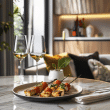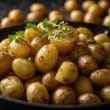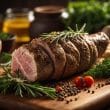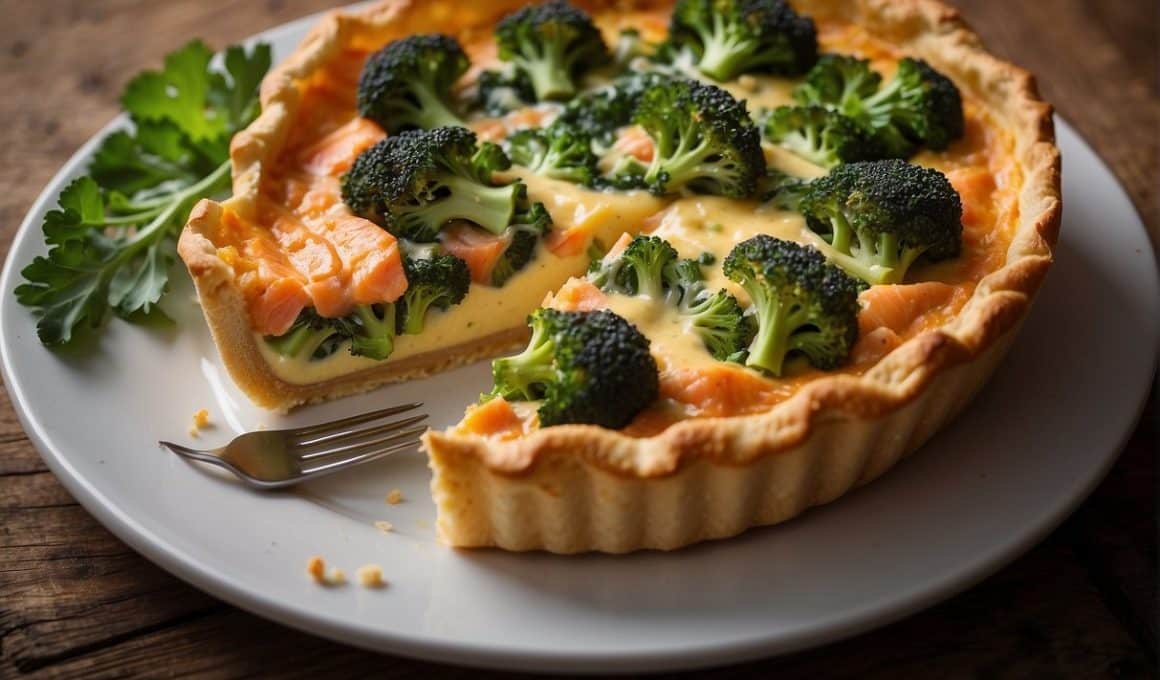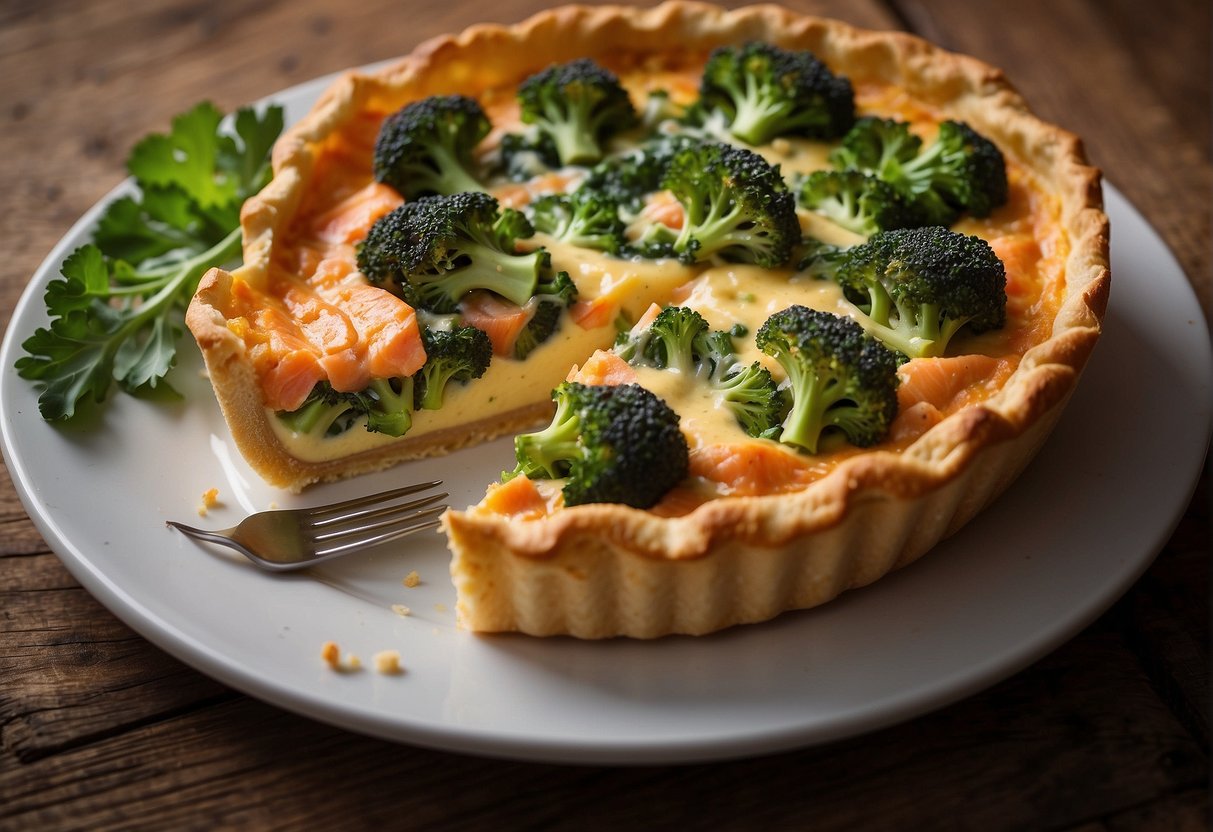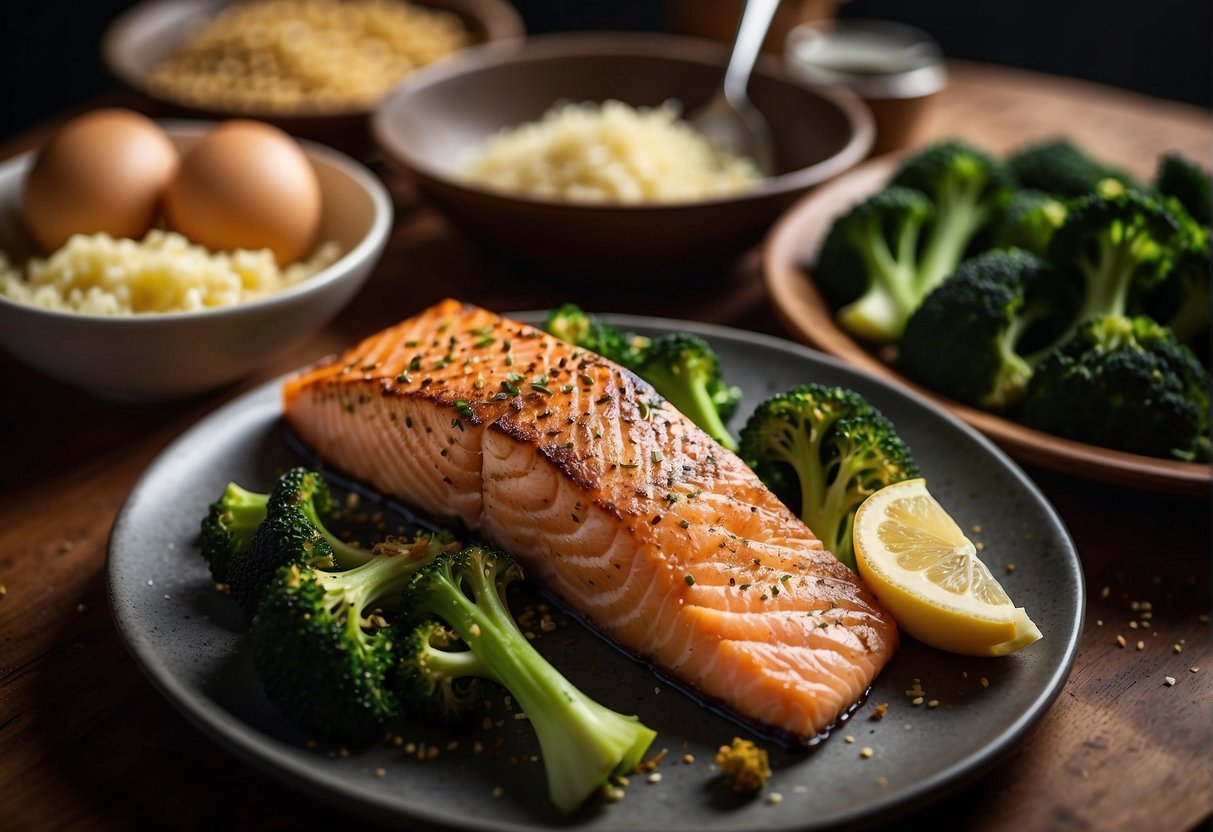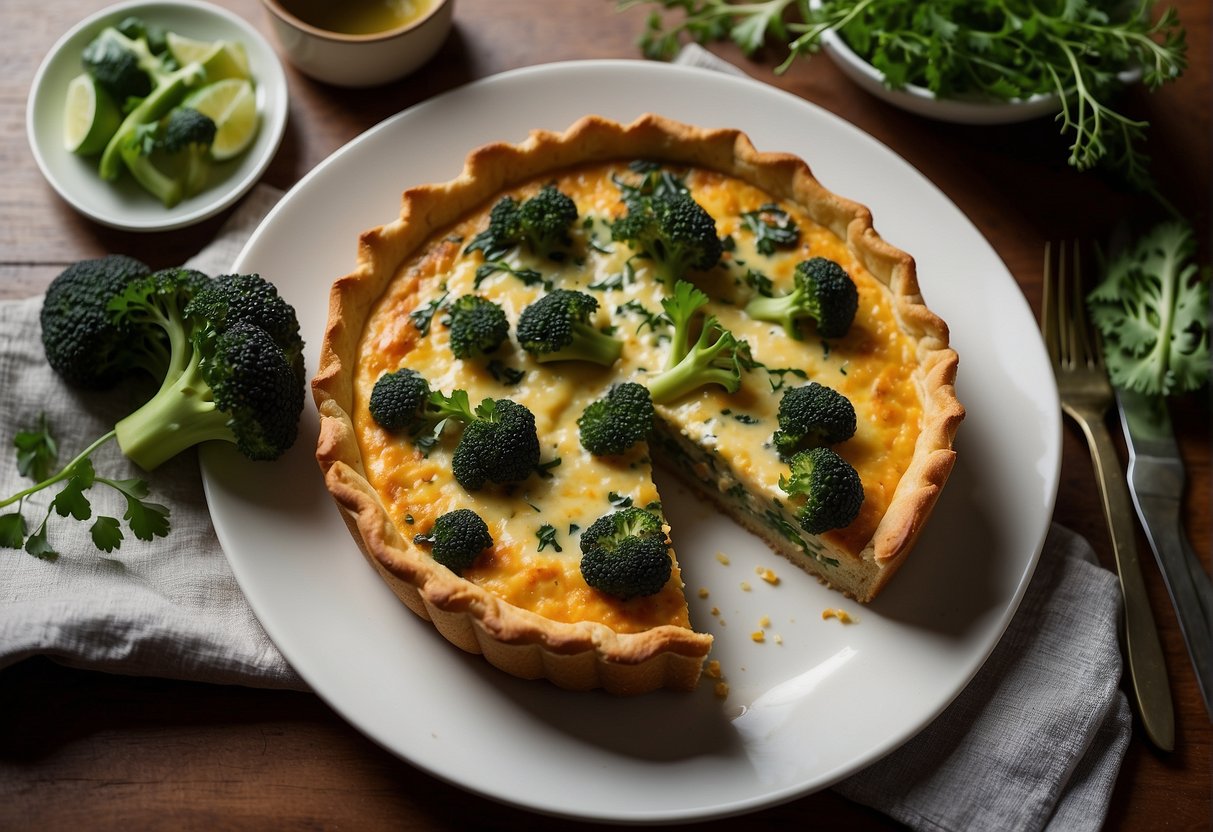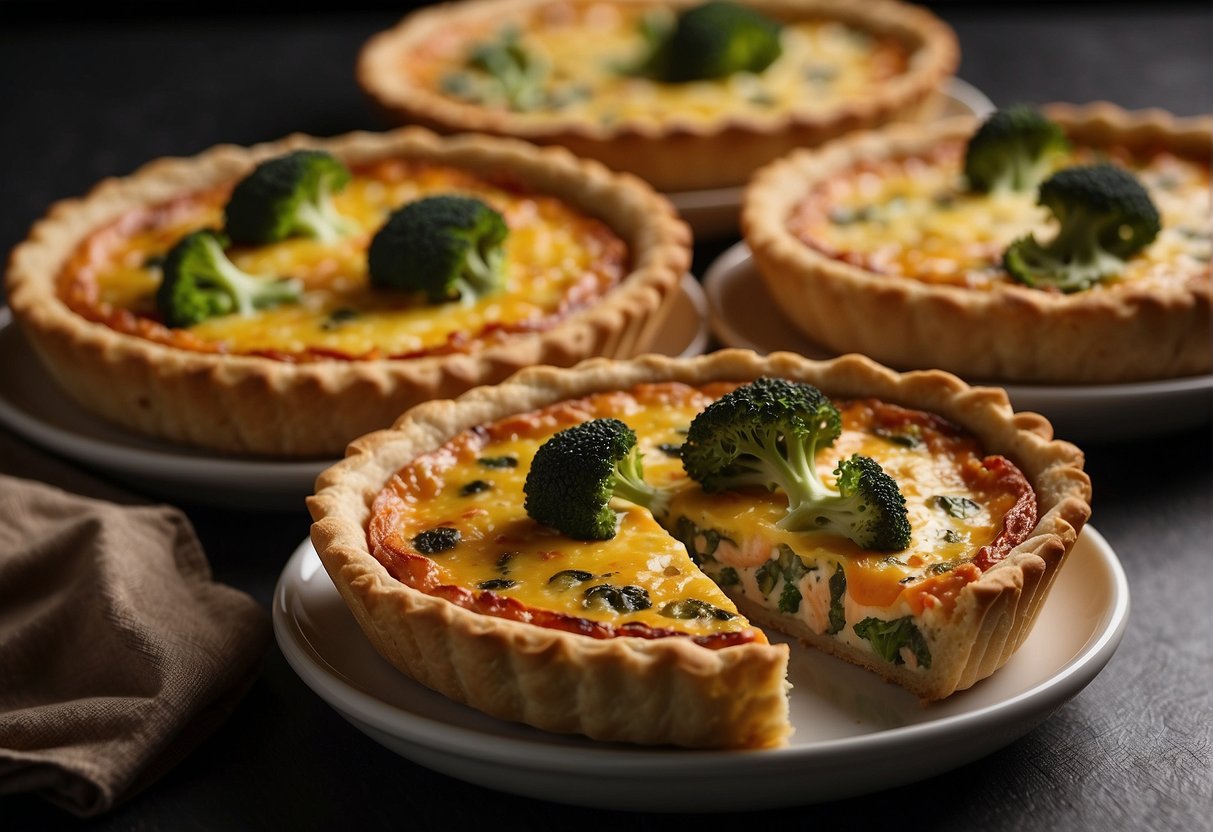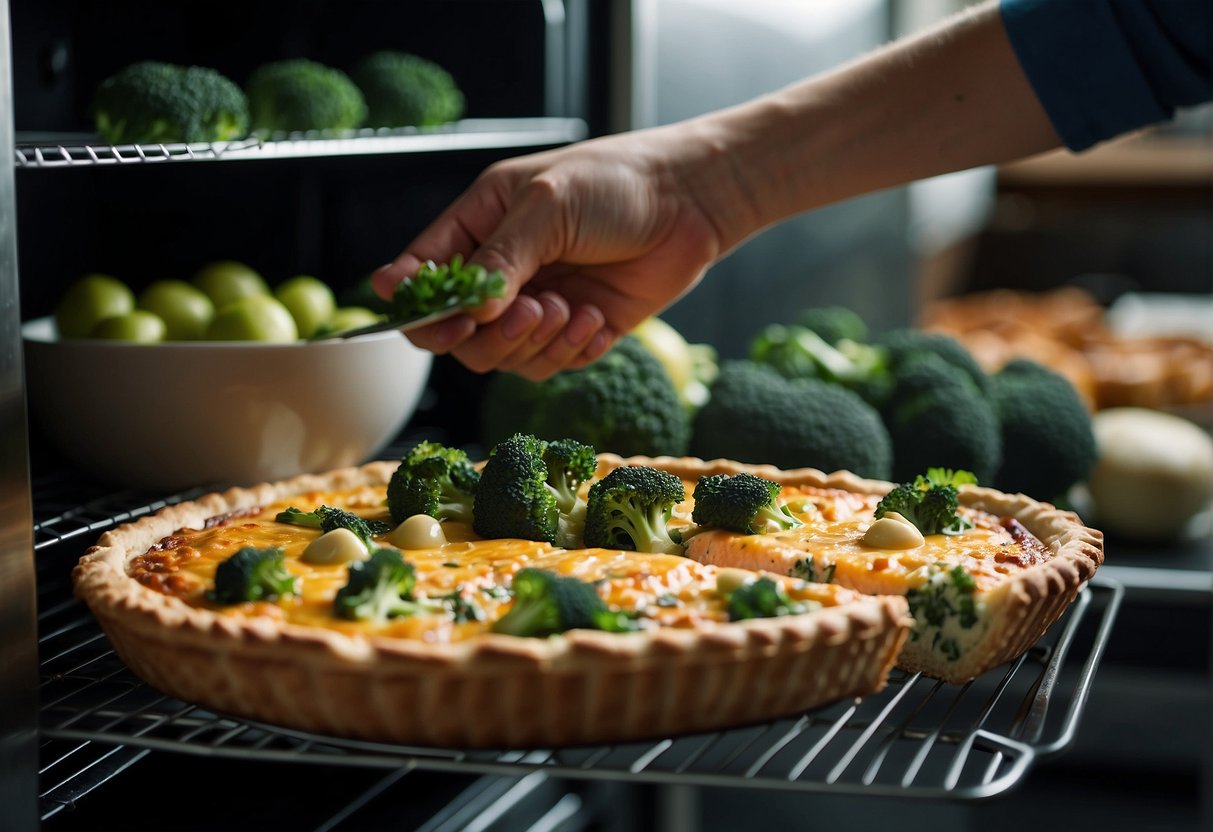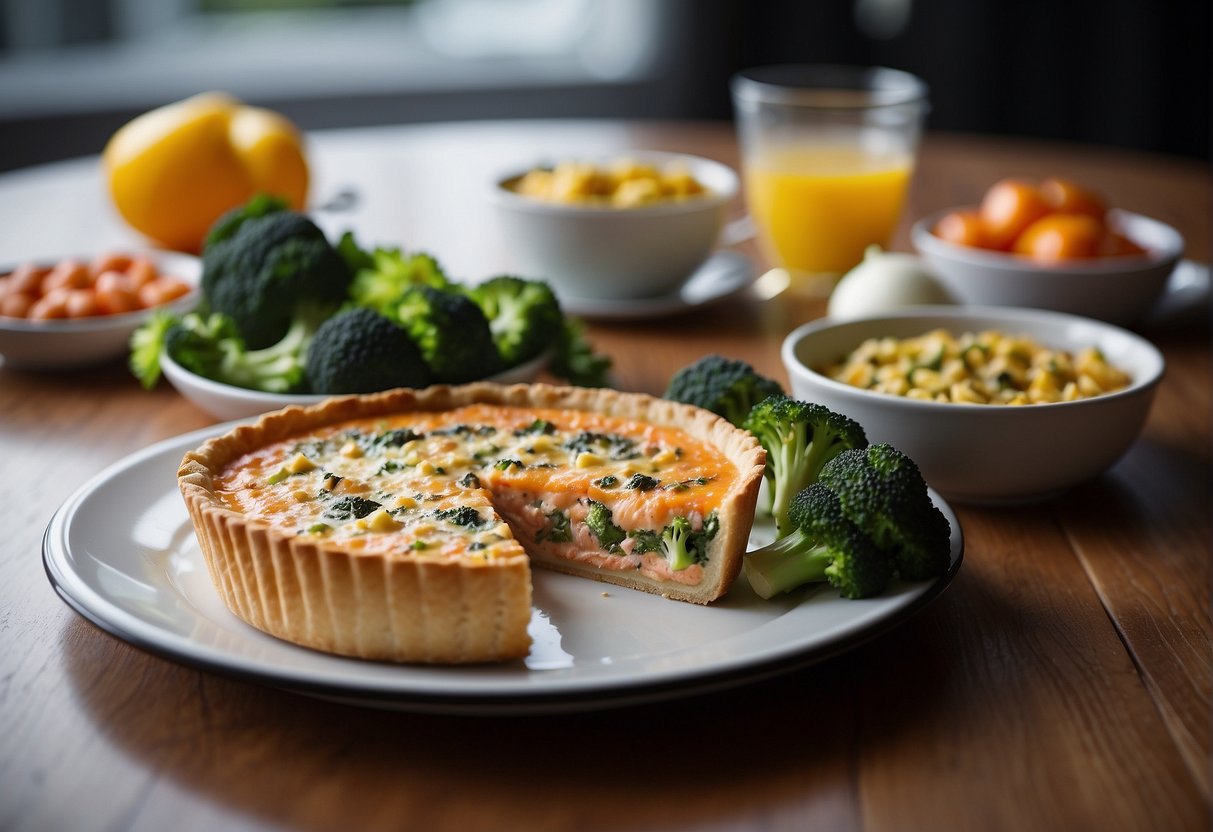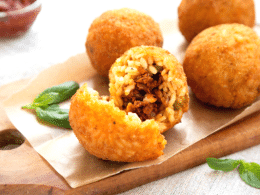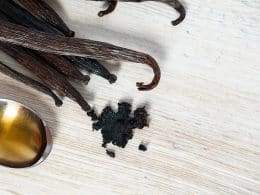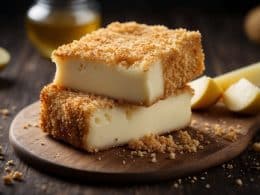I find the salmon and broccoli quiche to be a versatile and nourishing dish that’s perfect for any meal, whether it’s brunch, lunch, or dinner. With its buttery pastry crust and a rich filling that combines the distinct flavors of tender salmon and fresh broccoli, this quiche is a delightful balance of taste and texture. The key to a perfect quiche lies in using quality ingredients and mastering a few basic preparation steps.
Making the quiche involves creating the ideal creamy egg mixture to envelop the chunks of salmon and florets of broccoli, which are often enhanced with a blend of cheeses or herbs for extra flavor. The cooking techniques for this dish are also straightforward, allowing even those new to baking to achieve a golden, flaky crust encasing a soft, savory center. As a fan of culinary experimentation, I appreciate the room this recipe allows for variations, which makes it adaptable to different tastes and dietary preferences.
Key Takeaways
- Salmon and broccoli quiche blends quality ingredients into a filling meal suitable for any time of day.
- The dish’s success hinges on simple cooking techniques and careful preparation.
- It offers flexibility in ingredients, making it customizable for various preferences.
Ingredients Overview
In preparing the components for a salmon and broccoli quiche, I focus on the freshness and quality of the salmon and broccoli, and I ensure the pastry has the right balance of flakiness and tenderness. The combination of dairy and eggs binds the filling, while the seasonings enhance the inherent flavors of the main ingredients.
Salmon
Salmon is the star of the dish and should be fresh, or high-quality canned salmon can also be used. I favor using boneless, skinless salmon fillets for their convenience and rich omega-3 fatty acids.
Broccoli
Fresh broccoli should be cut into small, bite-sized chunks to distribute evenly throughout the quiche. Broccoli not only adds color but also contributes essential nutrients and a subtle crunch.
Pastry Components
My pastry comprises plain flour, cubed butter, and just enough cold water to bring it together. I avoid overworking the dough to ensure it remains flaky and light. The pastry serves as a buttery foundation that complements the filling.
Dairy and Eggs
The harmony of heavy cream, mozzarella cheese (for its sensational melt), and eggs forms a creamy custard that envelops the salmon and broccoli, setting firmly as it bakes. Alternatives like milk can be used for a lighter texture, whereas the inclusion of eggs is non-negotiable for the structure of the quiche.
Flavor Enhancers
To season, I use salt and black pepper for baseline seasoning. When available, a touch of dill pairs beautifully with salmon, and a hint of Dijon mustard can be whisked into the cream mixture for a subtle tang. These enhancers should be used judiciously to complement rather than overshadow the main ingredients.
Preparation Steps
Before diving into the various steps, I’ll guide you through how to handle salmon with care, prepare the perfect dough for the crust, mix a filling that is flavorful and well-balanced, and assemble the quiche for an ideal bake.
Handling Salmon
To start off, I make sure my salmon is fresh, boneless, and skinless; I find it best to use a fillet weighing about 140g. I either cut it into small chunks or, if it’s leftover cooked salmon, I ensure it’s flaked. I always handle salmon with clean hands and utensils to avoid cross-contamination.
Preparing Dough
For a flaky crust, I combine 2¼ cups of flour with ¾ cup of cold butter, cubed into small pieces, and a teaspoon of salt for flavor. I incorporate the mixture using my fingertips until it resembles coarse bread crumbs. Gradually, I add 4-6 tablespoons of cold water as I stir with a fork. Once the dough comes together, I form it into a ball, wrap it in plastic wrap, and chill it in the fridge for at least an hour, which makes it easier to handle later on.
Mixing Filling
I whisk together eggs and heavy cream—quantities depend on the specific recipe, but it’s typically around 1 cup of cream to 3 eggs. I season the mixture with salt, cracked black pepper, and other desired herbs and spices. I then finely chop my additional vegetables—commonly onions and broccoli—making sure they’re uniform in size to cook evenly.
Assembling Quiche
First, I preheat my oven to the temperature specified by the recipe, usually around 375 degrees Fahrenheit. On a lightly floured work surface, I roll out the chilled dough to fit my pastry case. I ensure it is gently placed in, not stretched, to avoid shrinkage during baking. Then, I sprinkle the salmon and vegetables evenly over the pastry case, before pouring in the filling. Lastly, I bake the quiche until it’s set and golden brown, checking it with a fork to make sure the center is cooked through.
Cooking Techniques
When preparing a salmon and broccoli quiche, employing the proper cooking techniques is essential to ensure that the dish is both visually appealing and delicious. I focus on the crust’s texture and the filling’s consistent cooking.
Blind Baking
Before adding the filling to a quiche, it’s crucial to blind bake the pastry crust. I start by rolling out my pastry and lining the quiche tin, ensuring to push the dough into the edges. Then, I chill the crust in the freezer for about 15 minutes to firm it up. This step prevents the crust from shrinking during baking. Next, I line the crust with parchment paper and fill it with rice or baking beans to weigh it down. I then blind bake the crust in a preheated oven at 375 degrees Fahrenheit for approximately 20 minutes, which solidifies the structure and prevents a soggy bottom.
Baking Quiche
After removing the weights and parchment, I pour in the egg, salmon, and broccoli mixture and return the quiche to the oven. The key here is to bake at a moderate temperature so the eggs set without becoming overcooked and rubbery. A temperature of 350 degrees Fahrenheit usually ensures the filling cooks evenly while the crust becomes perfectly crisp.
Achieving Golden Brown Crust
To achieve a golden brown crust, I brush the edges of the pastry with beaten egg or milk before the quiche’s final stint in the oven. This creates a beautiful, glossy finish as the quiche bakes. If the edges brown too quickly, I cover them with strips of foil to prevent burning while allowing the rest of the quiche to bake to perfection.
Serving Suggestions
When I prepare salmon and broccoli quiche, I pay particular attention to the accompaniments and serving temperature to enhance the dining experience.
Garnishes and Sides
For a visually appealing presentation and a burst of flavor, I like to top my quiche with fresh herbs like dill or parsley. A mixed salad on the side, lightly dressed with vinaigrette, complements the richness of the quiche. Seasonal greens like spinach, peas, or blanched asparagus add a refreshing crunch and nutritional boost. Occasionally, for a tangier taste, I’ll sprinkle some whole grain mustard over the greens.
Serving Temperature
The serving temperature of a quiche can substantially affect its taste and texture. I’ve found that a salmon and broccoli quiche is ideal when served warm. This allows the flavors to meld perfectly and the cheese to remain slightly melted. However, it’s crucial that the quiche rests for a few minutes after baking — this ensures it’s easy to cut and the structure is set. If serving this dish as a main course, I ensure it’s the highlight of the meal by keeping it at center stage both in presentation and serving temperature.
Variations of the Quiche
Quiche is a wonderfully flexible dish, and I love experimenting with different ingredients. One such variation is using smoked salmon. The rich, smoky flavor pairs beautifully with the creamy quiche filling. When I incorporate smoked salmon, I often add a touch of dill and capers for that extra zing.
For those preferring a more traditional taste, Quiche Lorraine is a classic. It’s made with bacon, lending a savory note that’s hard to resist. If, like me, you’re sometimes in a rush and need a quicker option, frozen broccoli can be a great time-saver in a broccoli quiche variation. I make sure to thaw and drain it well to avoid excess moisture.
- Smoked Salmon Variation:
- Adds a smoky flavor
- Pairs well with dill and capers
- Quiche Lorraine:
- Features bacon
- A savory classic
When I’m looking for a vegetarian option, spinach is my go-to. It’s not only healthy but also provides a beautiful color and texture to my quiche. And if you’re seeking a bit of crunch and sweetness, finely chopped leek works wonders.
- Spinach Variation:
- Offers a healthy twist
- Contributes vibrant color
Creating mini quiches can be quite fun, too. They’re perfect for brunches or as appetizers. I’ve found that any combination of the above, whether it be leeks with bacon or smoked salmon with spinach, can make delightful bite-sized treats.
- Mini Quiches:
- Ideal for parties
- Combine various flavors
My advice for quiche variations? Be bold and use what’s available. Whether it’s making use of leftovers or exploring new flavor combinations, the quiche is a canvas waiting for your personal touch.
Storing and Reheating
When it comes to extending the enjoyment of my homemade salmon and broccoli quiche, proper storage and reheating are crucial. I ensure my quiche retains its flavor and texture by following these specific guidelines.
Refrigeration Tips
In the refrigerator, I store my quiche properly to maintain freshness. After allowing the quiche to cool completely, I wrap it in plastic wrap or aluminum foil. Sometimes, I’ll place a layer of parchment paper before wrapping to prevent sticking. I make sure it’s sealed well to avoid absorbing any odors from the fridge. Typically, it stays good for 3-4 days when refrigerated like this.
- Cool: Allow to reach room temperature
- Wrap: Plastic wrap or aluminum foil
- Layer: Parchment paper beneath wrap
- Fridge Life: 3-4 days
Freezer Instructions
For longer storage, freezing the quiche is my go-to method. I cut the quiche into portions and wrap each piece individually in plastic wrap, followed by a layer of aluminum foil. Then, I place the portions in a food processor safe bag to protect against freezer burn. The quiche can be frozen for up to 3 months. To thaw, I transfer it to the refrigerator overnight.
- Wrap Individually: Plastic wrap then aluminum foil
- Bag: Food processor safe for freezer
- Freeze: Up to 3 months
- Thaw: Overnight in the refrigerator
Reheating for Best Taste
To reheat the quiche and preserve its creamy texture, I preheat the oven to 350 degrees Fahrenheit. I then cover the edges of the crust with foil to prevent over-browning and place the quiche on a baking sheet. A whole quiche takes approximately 20-25 minutes to warm up, while individual slices take about 15 minutes. For the best internal temperature, I aim for 165 degrees Fahrenheit. If using a microwave for convenience, I cover the slice with a paper towel to absorb excess moisture and use the medium power setting to avoid rubbery eggs.
- Oven: 350 degrees Fahrenheit, with crust edges covered in foil
- Whole Quiche: 20-25 minutes to reheat
- Slices: 15 minutes in the oven
- Microwave: Covered with paper towel, medium power setting
Nutritional Information
When I prepare salmon and broccoli quiche, I’m not just crafting a delicious meal; I’m also offering a dish that’s nutritionally dense and beneficial to my health. It’s a perfect balance of proteins, essential fats, and vital nutrients.
Health Benefits
The combination of salmon and broccoli in this quiche enhances its health profile significantly. In a salmon and broccoli quiche, we’re looking at substantial protein content, which is critical for muscle repair and growth. Moreover, salmon is a well-known source of omega-3 fatty acids, which are crucial for heart health and cognitive functions.
- Protein: Essential for muscle maintenance and growth.
- Omega-3 Fatty Acids: Support heart health and cognitive function.
Broccoli contributes additional nutritional benefits, such as dietary fiber, vitamins C and K, and calcium, which is imperative for bone health.
- Fiber: Aids in digestive health.
- Vitamins C and K: Important for immune function and blood clotting.
- Calcium: Vital for strong bones and teeth.
Eating this quiche contributes positively to a balanced diet, incorporating diverse groups of nutrients that are beneficial for overall wellness.
Dietary Considerations
Before indulging in a slice of quiche, it’s crucial to take into account its calorie content and balance it within the day’s total intake. According to nutrition facts from Eat This Much, a typical serving contains substantial calories, which must be factored into a balanced diet.
Focusing on dietary balance, for individuals monitoring carbohydrate intake, it’s important to note the net carbs present in the quiche, after taking fiber into account. If I’m keeping an eye on my fat intake, I also pay attention to the amount of fat in each serving, ensuring it aligns with my nutritional goals. For those who require increased protein, such as athletes or people on high-protein diets, this quiche can be an excellent addition to their meal plan due to its high-protein ingredients.
In summary, by understanding these considerations, I can integrate salmon and broccoli quiche into my diet in a way that supports my health and dietary objectives.
Tips and Tricks
When making salmon and broccoli quiche, my focus is always on achieving a perfect crust, a creamy custard filling, and selecting ingredients that ensure freshness and quality. Here’s how I make sure my quiche stands out.
Perfect Crust
To create the perfect quiche crust, I recommend using a combination of pie weights during the blind baking process. This includes using actual pie weights, but in their absence, rice or dry beans work just as effectively to prevent the crust from bubbling up or shrinking.
- Blind Baking: Preheat your oven to 375°F (190°C) and place your dough in the pie dish. Cover it with parchment paper and spread your pie weights evenly. Bake for about 15 minutes before removing the weights and baking for an additional 5 minutes until it’s lightly golden.
Creamy Custard Filling
A silky, creamy custard defines a memorable quiche. I achieve this by using heavy cream, or double cream where available, for a richer and more decadent texture.
- Mixing the Custard: In a mixing bowl, whisk together 5 eggs and 1 cup (240ml) of heavy cream until smooth. This ratio ensures that the quiche sets properly while remaining moist and tender.
Freshness and Quality
For me, the quality of a quiche is evident in the freshness of its ingredients. I choose boneless, skinless salmon fillets and fresh broccoli, which offer vibrant color and flavor.
- Selecting Fresh Ingredients: Look for salmon with a bright color and firm texture, and broccoli that has a deep green hue with tight florets.
- Preparation: Steam the broccoli until it’s just tender, and flake the salmon carefully, checking for any remaining bones.
By adhering to these practical steps with attention to quality ingredients and methodical preparation, I create a quiche that’s consistently delicious and impressive to serve.
Additional Resources
When crafting a salmon and broccoli quiche, it’s valuable to have a variety of resources to reference. Whether you’re a seasoned cook or a beginner in the kitchen, having access to detailed recipes and cookbooks can be immensely helpful.
Favorite Recipes:
For those seeking a precise recipe, I find the British Chefs Table’s take on Mary Berry’s version quite delightful. It’s carefully balanced and straightforward to follow.
Cookbooks:
If you’re on the hunt for a cookbook that expands beyond a single recipe, my top recommendation generally includes titles like “Quiche Mastery.” It often ranks high amongst best sellers due to its variety of quiche recipes.
Top 5 Recommendations:
- Quiche Essentials by Amy Stevenson
- The Perfect Pie by Sarah Perry
- Quiche and Beyond by Fiona Adams
- Whisk & Dine by Charlotte M. Thompson
- Rustic Quiche Artistry by Owen B. Williams
These cookbooks are my go-to resources because they combine user-friendly instructions with a deep understanding of flavor pairings and baking techniques.
Remember, when selecting a cookbook or a recipe, ensure that they match your skill level and culinary preferences. Happy baking!
Frequently Asked Questions
In this section, I address common queries about preparing salmon and broccoli quiche, offering straightforward advice for both classic preparations and healthier alternatives.
What ingredients are needed for a crustless salmon and broccoli quiche?
For a crustless salmon and broccoli quiche, you’ll need fresh or canned salmon, broccoli florets, eggs, cheese, and seasonings. Here’s a detailed recipe for your reference.
How can I make a healthier version of salmon and broccoli quiche?
A healthier salmon and broccoli quiche can be made by using low-fat dairy options, increasing the proportion of broccoli, and incorporating whole-grain flour if you’re not going crustless.
Can canned salmon be used in a broccoli quiche and how does it differ from using fresh salmon?
Yes, canned salmon can be used in a broccoli quiche as a convenient alternative to fresh salmon. The texture and taste may vary slightly, with canned salmon being softer and saltier. Delia Smith offers a version using smoked salmon, which can also be substituted with canned salmon.
What are the steps to creating an easy salmon and broccoli quiche?
Creating an easy salmon and broccoli quiche involves preparing the crust (if using), mixing eggs, cream, and seasonings, and then layering the salmon, broccoli, and egg mixture before baking. Here’s a simple recipe to guide you through the process.
How can I substitute cream in a salmon and broccoli quiche recipe?
To substitute cream in a salmon and broccoli quiche, you can use milk, a blend of milk and yogurt, or a dairy-free milk alternative like almond or soy milk for a lighter option.
Are there any tips for ensuring a salmon and broccoli quiche comes out perfectly when following a BBC recipe?
When following a BBC recipe or any other recipe, ensure your quiche comes out perfectly by pre-cooking the broccoli to al dente, using well-drained salmon, and avoiding overmixing the egg mixture. BBC Good Food often provides tested tips for quiche success.

